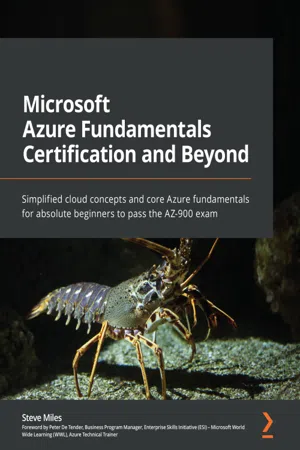
- 424 pages
- English
- ePUB (mobile friendly)
- Available on iOS & Android
Microsoft Azure Fundamentals Certification and Beyond
About this book
Gain in-depth knowledge of Azure fundamentals that will make it easy for you to achieve AZ-900 certificationKey Features• Get fundamental knowledge of cloud concepts and the Microsoft Azure platform• Explore practical exercises to gain experience of working with the Microsoft Azure platform in the real world• Prepare to achieve AZ-900 certification on the first go with the help of simplified examples covered in the bookBook DescriptionThis is the digital and cloud era, and Microsoft Azure is one of the top cloud computing platforms. It's now more important than ever to understand how the cloud functions and the different services that can be leveraged across the cloud. This book will give you a solid understanding of cloud concepts and Microsoft Azure, starting by taking you through cloud concepts in depth, then focusing on the core Azure architectural components, solutions, and management tools. Next, you will understand security concepts, defense-in-depth, and key security services such as Network Security Groups and Azure Firewall, as well as security operations tooling such as Azure Security Center and Azure Sentinel. As you progress, you will understand how identity, governance, privacy, and compliance are managed in Azure. Finally, you will get to grips with cost management, service-level agreements, and service life cycles. Throughout, the book features a number of hands-on exercises to support the concepts, services, and solutions discussed. This provides you with a glimpse of real-world scenarios, before finally concluding with practice questions for AZ-900 exam preparation. By the end of this Azure book, you will have a thorough understanding of cloud concepts and Azure fundamentals, enabling you to pass the AZ-900 certification exam easily.What you will learn• Explore cloud computing with Azure cloud• Gain an understanding of the core Azure architectural components• Acquire knowledge of core services and management tools on Azure• Get up and running with security concepts, security operations, and protection from threats• Focus on identity, governance, privacy, and compliance features• Understand Azure cost management, SLAs, and service life cyclesWho this book is forThis Azure fundamentals book is both for those with technical backgrounds and non-technical backgrounds who want to learn and explore the field of cloud computing, especially with Azure. This book will also help anyone who wants to develop a good foundation for achieving advanced Azure certifications. There is no prerequisite for this book except a willingness to learn and explore cloud concepts and Microsoft Azure.
Frequently asked questions
- Essential is ideal for learners and professionals who enjoy exploring a wide range of subjects. Access the Essential Library with 800,000+ trusted titles and best-sellers across business, personal growth, and the humanities. Includes unlimited reading time and Standard Read Aloud voice.
- Complete: Perfect for advanced learners and researchers needing full, unrestricted access. Unlock 1.4M+ books across hundreds of subjects, including academic and specialized titles. The Complete Plan also includes advanced features like Premium Read Aloud and Research Assistant.
Please note we cannot support devices running on iOS 13 and Android 7 or earlier. Learn more about using the app.
Information
Section 1: Cloud Concepts
- Chapter 1, Introduction to Cloud Computing
- Chapter 2, Benefits of Cloud Computing
Chapter 1: Introduction to Cloud Computing
- Define cloud computing.
- Describe public cloud, private cloud, and hybrid cloud.
- Compare and contrast the three types of cloud computing.
- Describe Infrastructure as a Service (IaaS), Platform as a Service (PaaS), Software as a Service (SaaS), and Serverless | Functions as a Service (FaaS).
- Identify a service type based on a use case.
- Azure Security Center and Azure Defender are now called Microsoft Defender for Cloud
- Azure Defender plans to Microsoft Defender plans
- Azure Sentinel is now called Microsoft Sentinel
- Azure Defender for IoT is now called Microsoft Defender for IoT
- Azure Defender for SQL is now called Microsoft Defender for SQL
- Microsoft Cloud App Security is now called Microsoft Defender for Cloud App
- Microsoft Defender for Business is introduced as a new Service SKU
Where has the cloud computing model evolved from?

Evolution of cloud computing architectures

Table of contents
- Microsoft Azure Fundamentals Certification and Beyond
- Foreword
- Preface
- Section 1: Cloud Concepts
- Chapter 1: Introduction to Cloud Computing
- Chapter 2: Benefits of Cloud Computing
- Section 2: Core Azure Services
- Chapter 3: Core Azure Architectural Components
- Chapter 4: Core Azure Resources
- Section 3: Core Solutions and Management Tools
- Chapter 5: Core Azure Solutions
- Chapter 6: Azure Management Tools
- Section 4: Security
- Chapter 7: Azure Security
- Section 5: Identity, Governance, Privacy, and Compliance
- Chapter 8: Azure Identity Services
- Chapter 9: Azure Governance
- Chapter 10: Azure Privacy and Compliance
- Section 6: Cost Management and Service-Level Agreements
- Chapter 11: Azure Cost Planning and Management
- Chapter 12: Azure Service-Level Agreements
- Chapter 13: Exam Preparation Practice Tests
- Other Books You May Enjoy